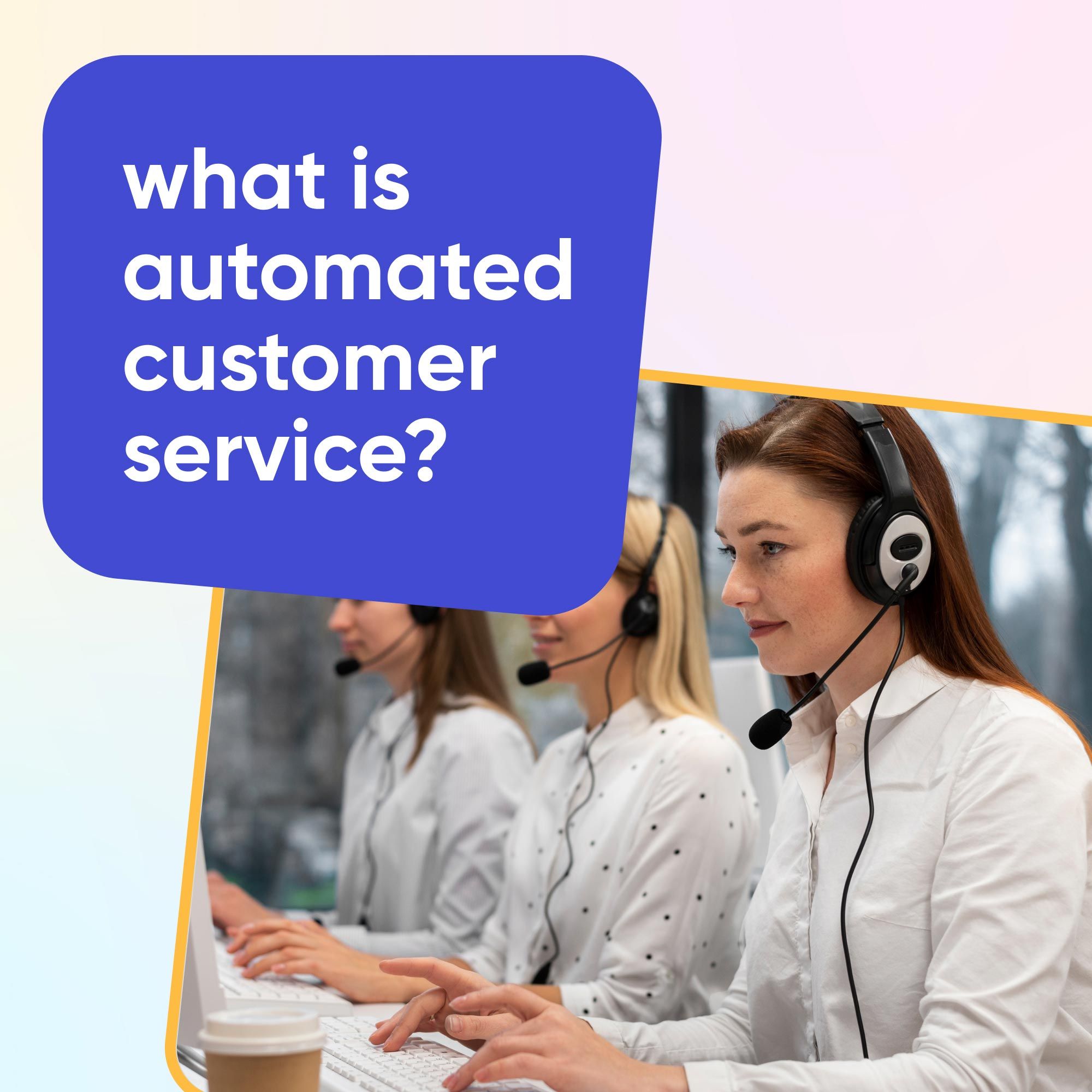In today's highly competitive market, customer service is not just an add-on; it's a cornerstone for business growth. The ability to swiftly address customer needs and provide timely assistance can make or break a company's reputation.
According to a study by HubSpot, 93% of customers are likely to make repeat purchases with companies that offer excellent customer service. This statistic highlights how essential it is to prioritize customer support, as each interaction can impact loyalty and revenue.
However, meeting the demands of a growing customer base can be a daunting task, especially as expectations for instant responses and personalized experiences continue to rise. This is where automated customer service steps in, revolutionizing the way businesses manage customer support.
In this blog, we'll explore the ins and outs of automated customer service, including its definition, benefits, real-world examples, how to implement customer service automation, and the future trends shaping this essential business tool.
What is Customer Service Automation?
Customer service automation (CSA) refers to the use of technology, such as AI-powered chatbots, voicebots, and automated systems, to handle customer queries and tasks without human intervention. By automating customer services, companies can provide faster, more consistent, and 24/7 support to their customers.
Automated customer service also supports teams by addressing simple questions, offering knowledge-based suggestions, and assisting in self-solvable requests to the respective agents.
Ready to see the benefits of customer service automation in action? Try Tring AI’s intelligent voice and chatbots today and transform your support experience!
Automated Customer Service Definition
Automated customer service leverages tools such as AI, machine learning, and natural language processing (NLP) to deliver personalized responses and resolve customer issues efficiently without the need for humans to overlook them. By following pre-set workflows and utilizing customer data, customer service automation has evolved to handle complex queries and provide assistance around the clock, making it an indispensable part of modern customer support.
Automated Customer Service Examples
By using AI-powered chatbots, voice assistants, and automated systems, companies can deliver fast, efficient, and 24/7 assistance to customers without compromising on quality. Businesses that have implemented automated customer service report impressive gains.
From e-commerce giants like Amazon, which uses AI-driven chatbots to streamline order inquiries, to banks like Bank of America, whose "Erica" virtual assistant has handled over 100 million interactions, automation is empowering companies to scale their customer service operations like never before.
Brands like Zappos use automated email systems to acknowledge customer inquiries instantly and provide timely updates. Research from Forrester indicates that self-service support can reduce operational costs by up to 30%, making it a cost-effective solution for businesses.
The impact of automating customer services is undeniable, ensuring every customer is valued and happy to take up your services. As technology evolves, the scope of customer support automation is doubling, pushing us to have a deeper understanding of customer care automation and the skyrocketing benefits it adds to every business.
7 Advantages of Automated Customer Service
If you’re looking to offer great service without breaking the bank, automation of customer service is the way to go. It’s a game-changer, especially if you’re dealing with a ton of customer requests every day - high quality, cost-effective and speedy.
Let’s explore the myriad advantages that come with implementing automated customer service solutions.
1. Boost Efficiency and Speed
Automated customer service can drastically enhance efficiency and speed. With systems designed to address inquiries quickly, brands can ensure rapid responses. Research shows that quick issue resolution increases customer retention, making speed a non-negotiable expectation for today’s tech-savvy consumers.
2. Provide 24/7 Support
Automated tools, like AI chatbots, offer 24/7 assistance, ensuring that your customers get help whenever they need it, regardless of time zones. This continuous support enhances the overall customer experience and keeps them satisfied.
3. Cut Service Costs
Customer service and support automation can significantly reduce operational costs. By handling multiple queries at once and minimizing the need for large support teams, businesses can streamline resources and maximize efficiency, leading to substantial cost savings over time.
4. Empower Human Agents
Automation isn't just for customers; it also benefits support agents! By taking over routine tasks, automation allows your team to focus on more complex issues. This shift can improve job satisfaction and productivity, freeing up to 30% of an agent's time.
Boost your efficiency and cut costs with Tring AI’s advanced AI bots. Sign up for a demo and discover how our automation solutions take your business to the next level!
5. Ensure Consistency
Implementing an automated customer service system offers a consistent brand voice across all interactions. This reliability builds trust with customers, as they know what to expect every time they engage with your brand.
7. Streamline Data and Analytics
Automated customer service generates a wealth of data. Leveraging AI tools helps categorize feedback and analyze customer sentiment, providing valuable insights for enhancing your customer support strategy and improving service-level agreements.
8. Personalize Customer Interactions
Today’s customers need personalized experiences, where support agents understand their queries and respond accordingly. Automated systems like AI chatbots can analyze customer data, tailoring interactions based on preferences and purchase history. This approach not only makes customers feel valued but also strengthens their loyalty to your brand.
How to Automate Customer Service?
In today's world, where immediate responses and seamless interactions are the norm, companies are challenged to evolve quickly to satisfy their customers' demands. As we embrace the wave of automated solutions, it’s crucial for organizations to leverage technology while still maintaining a balance between efficiency and empathy for building lasting relationships.
Here are effective strategies to implement customer service automation and optimize your support processes:
1. Leverage AI-Powered Chatbots
AI chatbots are transforming customer support by delivering instant assistance and managing simple inquiries around the clock. They learn from past interactions and personalize responses based on customer data, resulting in a more engaging experience. According to recent studies, 55% of customers have used chatbots for basic service needs, emphasizing their growing importance in customer service automation.
2. Automate Repetitive Tasks
Identify and streamline tedious tasks like data entry and appointment scheduling. By automating these processes, your team can focus on resolving more complex issues and nurturing customer relationships, thereby enhancing customer care automation.
3. Develop a Comprehensive Knowledge Base
A well-maintained knowledge base is crucial for enabling customers to find answers independently. Providing FAQs, guides, and tutorials empowers users to resolve issues themselves. Regular updates to this resource are essential, as many customers now prefer self-service options, reinforcing the importance of effective customer service automation.
4. Evaluate and Enhance Workflows
Conduct regular reviews of your existing support workflows to pinpoint automation opportunities. By digitizing elements of the customer support process, you equip agents with tools that foster quicker and more efficient service, ultimately enhancing automated customer service systems.
5. Integrate with Existing Tools
Improve your customer care automation by integrating it with popular applications. This not only streamlines repetitive tasks but also ensures a seamless experience across various channels, supporting your overall customer support strategy.
6. Implement Intelligent Helpdesk Solutions
Utilize intelligent help desk technology featuring AI-driven ticketing and automated routing. This automation can significantly reduce response times and improve the accuracy of information provided to customers.
7. Create Consistent Templates:
Develop templates for automating customer service interactions to ensure alignment with your brand’s voice and values. This expedites response times without compromising quality is crucial for effective interactions.
8. Ensure Human Support Integration
While automation handles many inquiries, some situations demand human intervention. Facilitate a smooth transition between automated systems and human agents, providing personalized assistance when necessary, to achieve a balanced approach to customer service.
10. Train Your Team Effectively
Equipping your support team with proper training is vital for successfully implementing an automated customer service system. Ensure agents understand how to leverage automated tools effectively and are familiar with best practices for customer interactions.
11. Collect and Analyze Customer Feedback
Regularly gather and review customer feedback to refine your automated service strategy. Use surveys and direct interactions to gain insights, allowing you to adjust your automation efforts continually.
Customer Service Automation Software and Tools
There are various customer service automation tools available to help businesses streamline their support processes. According to Gartner, by 2025, 40% of customer service interactions will be handled by automated agents, demonstrating the growing reliance on AI and automation.
Tring AI Bots – Provides voicebot and chatbot solutions that mimic human-like conversations, allowing for a more personalized automated experience.
Zendesk – offers AI-powered chatbots, automated workflows, and integrated help desk features.
Intercom – Known for its advanced automation features and customizable chat widgets.
Freshdesk – A popular choice for businesses looking to implement ticket automation and AI chat support.
How to Get a Human in an Automated System?
For businesses, it's crucial to make it easy for customers to escalate their issues to human agents when necessary. Implement options like "Speak to an Agent" or "Escalate Issue" to ensure a seamless transition from automated systems to human support.
Human-like advanced AI chatbot and voice bot powered by Tring AI do exactly that. The bots' exceptional features, such as empathetic responses and intent recognition, set them apart from the rest, transforming automated customer service into a never-before-seen experience.
Future of Automated Customer Service Automation
The future of customer service automation looks promising, with advancements in AI and machine learning leading to more sophisticated and intuitive systems. Emerging trends include:
- Hyper-Personalization: AI will soon be able to deliver even more personalized responses based on individual customer behavior and preferences.
- Voice-Activated Support: The rise of voice assistants like Alexa and Siri indicates a shift towards voice-driven customer service automated solutions.
- Proactive Service Automation: Predictive analytics enables companies to anticipate customer needs before they arise, providing predefined notifications about order details, such as order status or product restock information.
Take the first step towards automating custom support services with Super-Intelligent Tring AI voicebot and chatbot.







